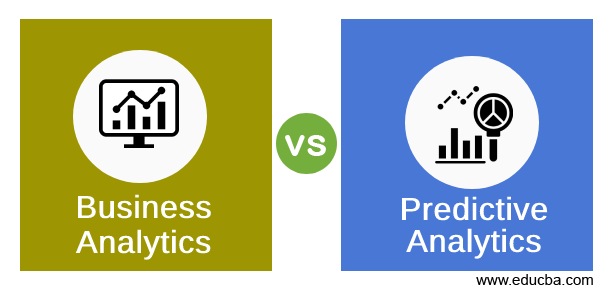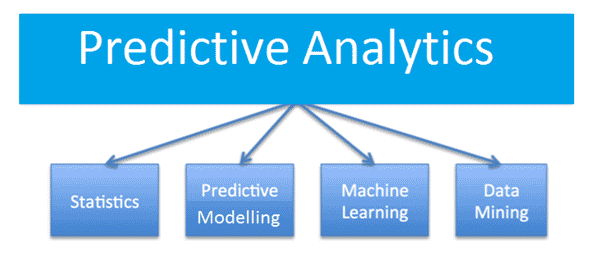Updated June 2, 2023
Difference Between Business Analytics vs Predictive Analytics
In the modern world, the technology used in business processes can confuse many people. Many technologies may seem to do the same job, but they have very different functionalities depending on how they are used. One example of this is the confusion between business analytics and predictive analytics. Even companies often confuse business analytics with predictive analytics or think that once they’re using business analytics for analysis of their data, then they’re doing all they can to get data insights from it. Due to this, they are not exploiting the full potential of their data.
Predictive analytics and business analytics seem to be the same but believe me; they are not. If you’re using your data for business analytics applications, you’re almost certainly not getting as much value from it as you could. But how exactly does predictive analysis differ from business analytics? Let’s find the difference between Business Analytics and Predictive Analytics in this post.
What is Business Analytics?
Business Analytics helps different organizations in better decision-making, leveraging a wide range of the latest tools and methods. BA involves data analytics, data mining, and big data processes and procedures that help make better business decisions. With recent advancements in BA tools, users can generate reports and visualizations without relying on IT staff.
Where can we use Business Analytics?
What is Predictive Analytics?
Predictive Analytics is a hot issue in today’s business and information technology world. Predictive analytics goes beyond these backward-facing views and uses the data you already hold in your business to look forward and tell you what will happen in the future. Not only that. Predictive modeling allows you to predict the outcome and tell you the next best thing to happen. And good predictive analytics tools will automate this process for you so that your business decision-making becomes fact-based and truly data-driven rather than based on subjective judgments and hunches.
Your business analytics tool can tell you which of your products is currently selling best and show you trends in your product sales over time up to this point. But what if you want to know how well a particular product will sell in the future? Perhaps you’re planning an advertising campaign. What effect will this campaign have on future product sales? Which of your customers are most likely to respond to the campaign? This is what predictive analytics can tell you.
Where can we use Predictive Analytics?
How Does Predictive Analytics Work?
Predictive analysis uses various models to analyze data. The most common is the predictive model algorithm, which focuses on individual customer behavior. Using sample data with known attributes, the model is trained and can analyze the new data and determine its behavior. This information can be used to predict how the customer might behave next.
Head-to-Head Comparison Between Business Analytics vs Predictive Analytics (Infographics)
Below are the Top 7 Comparison Between Business Analytics vs Predictive Analytics:
Key Difference Between Business Analytics vs Predictive Analytics
Below is the difference between Business Analytics vs Predictive Analytics are as follows:
1. The role of traditional Business Analytics was to provide information to the users about the past performance of their business operations and was used mainly for reporting purposes.
Predictive Analytics uses forecasting techniques that help address the business environment’s complex issues. It also uses advanced quantitative methods, including descriptive and predictive data mining and simulations, that can provide better business insights than the traditional approaches used by Business Analytics.
2. Business Analytics relies on methods such as querying, reporting, dashboards, and OLAP using a set of metrics focusing on past performance.
On the other hand, Predictive Analytics helps predict future events and helps explore patterns that may be more complex to detect.
3. With Business Analytics, the analysis is designed to be more repetitive based on reporting templates that extract specific information related to the business to assess historical performance.
Predictive Analytics comes up with a question first. Then a set of analyses is performed to do deep research using statistical and quantitative data and algorithms to provide insights into the question.
Comparison Table
The comparison table between Business Analytics vs Predictive Analytics is mentioned below:
| Basis For Comparison | Business Analytics | Predictive Analytics |
| Objective | Business Analytics is about descriptive analytics or looking at what happened. | Predictive analytics is about finding hidden patterns using complex mathematical algorithms that can be used to predict future outcomes. |
| Data | With BA, raw data is processed into information regarding Products, Clients, Regions, Quarters for sales, etc. | With predictive analytics, however, raw data is processed into “cleaned data” for algorithm consumption. The volume and complexity of the data are more than our grey matter can digest. |
| Insight | With BA, people get insights to solve a business problem, often including guesswork, assumption-making, and reliance on subjective experience. | With predictive analytics, algorithms detect complex patterns and create a model that is the insight, powerfully illuminating logical pathways to address your key business concerns. |
| Decision | With BA, people decide what to do with their insight without strong, tangible evidence that they are correct. | With predictive analytics, the model tells you the best decision based on the data presented. |
| Data Types | Structured data, traditional sources, and manageable data sets. | Structured/Unstructured data, Internal/External data, massive data sets. |
| Technologies | Standard and ad-hoc reporting, dashboards, and alerts. | Predictive modeling, forecasting, and statistical analysis. |
| Common Questions | What happened last quarter?
How many did we sell? |
What is the optimal scenario for our business?
What will happen next? What if this trend continues? Why is this happening? |
Conclusion
Predictive analytics takes business analytics to the next level, moving from a retrospective set of answers based on historical data to a group of solutions focused on future perspectives, which helps predict performance and prescribe recommendations. No matter what, you still need business analytics to know what happened in the past, but you also need predictive analytics to see what you can do in the future.
Recommended Articles
This has been a guide to Business Analytics vs Predictive Analytics. Here we have discussed Business Analytics vs Predictive Analytics head-to-head comparison, key differences, and a comparison table. You may also look at the following articles to learn more –






